FOXY GRAPES
A Bad Rap
The word foxy has not been complimentary to grapes. It refers to the dominant flavor in one of our native species, the fox grape (Vitis labrusca). Around 1880, the botanist William Bartram went so far as to suggest that the epithet foxy was applied to this grape because of the “strong, rancid smell of its ripe fruit, very like the effluvia from the body of a fox.” (Others more generously suggested the epithet came about because foxes ate the grapes, or because the leaves resembled fox tracks.)
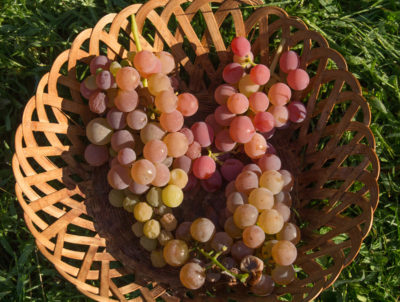
Glenora and Vanessa seedless grapes
Although native Americans ate this grape, early white settlers, well before the time of Bartram, had been unimpressed by the flavor. In 1672, John Josselyn wrote that fox grapes had “a taste of gunpowder.” Two Dutchmen visiting New York in 1679 recounted how they “went along the shore to Coney Island . . . and discovered on the roads several kinds of grapes still on the vines, called speck [fox] grapes, which are not always good, and these were not; although they were sweet in the mouth at first, they made it disagreeable and stinking.”
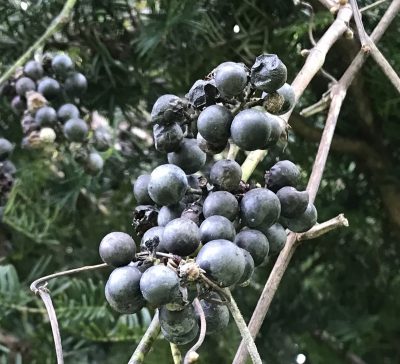
Fox grapes
Wherever white settlers landed in America, they attempted to establish plantings of the grape with which they were familiar, the European wine or vinifera grape (V. vinifera), which was the grape cultivated in the Old World since biblical times. In America, vinifera culture began as long ago as 1619, when the best vines and skilled growers were brought from France to establish a vineyard in Virginia. That planting and virtually all subsequent plantings in the East failed because vinifera grapes can’t tolerate the cold winters or the insects and diseases to which our native grapes are accustomed.
What’s the Difference?
In spite of repeated, futile attempts at growing vinifera grapes in the East, few people considered growing our tougher, native grapes before the nineteenth century. Only then were superior varieties developed, beginning with Catawba about 1820.

One reason for the delayed interest in fox grapes was because vinifera is the better fruit for wine, and it was not until the nineteenth century that fruits generally were appreciated for fresh eating. (“Wine” recalls another possible source for the epithet foxy; horticulturalist Liberty Hyde Bailey suggested in 1898 that the name arose due to “the lively foxing or intoxicating quality of the poor wine which was made from the wild grape.”)
As you might imagine, fruits of vinifera and fox grapes are quite different. You can pick out the difference from the grocer’s shelf today. The fox grape is represented by Concord: bite into a berry and the thick skin slips off the jelly-like meat, releasing a strong, aromatic, though not excessively sweet, flavor. The vinifera grape is represented by Thompson Seedless: eat the whole berry, tender skin and all; the fruit is sweet, with a neutral flavor. Vinifera berries are less apt to shake off the bunches, so ship better, which is one reason why Concord grapes usually show up in markets only near where they are grown.

Concord grape
I Like Foxiness
All this verbiage isn’t an academic exercise in grape history. If you grow grapes, as I do, survival of the vines and taste of the fruits is important. Vinifera are occasionally grown with success in the Northeast, but 300 years of mostly failure should teach something.
For those gardeners who strive for a grape akin to vinifera, there are hybrids between vinifera and fox grapes. Actually, most grape varieties these days are hybrids of vinifera, labrusca, and often some other species. Hybrids exhibit the full spectrum in flavor, hardiness, and pest tolerance, depending on which varieties were used as their parents.
If you live in a environment inimical to vinifera grapes and you’re interested in growing grapes closer in flavor (or lack thereof, in my opinion) to Thompson Seedless, hybrids such as Himrod and Lakemont are fairly cold hardy and can be grown at favorable sites, preferably south facing slopes in full sun. A bit more foxy, unfortunately only fairly cold hardy, is Vanessa, a delectable small berry which is pale red, crisp, sweet and flavorful.
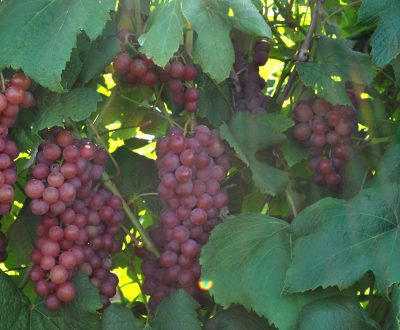
Vanessa grapes
I have grown one vinifera variety, thus far in a large pot in my greenhouse. This one, Perle de Csaba, and I’m sure some other viniferas, does have a distinctive, delicate flavor, besides being sweet and seedless, and wrapped in a tender skin.
Notwithstanding the previous testimony against foxiness in grapes, I happen to like my grapes foxy. And I’m not alone: Ulysses P. Hedrick, who wrote The Grapes of New York early in the last century, conceded that many vinifera grapes “are without character of flavor” compared to American grapes, which are “more refreshing . . . do not cloy the appetite,” and make a better juice. My taste preference is fortunate, because in my farmden, here in the bottom of the bottom of a frost pocket, grapes are particularly prone to both cold injury and disease.
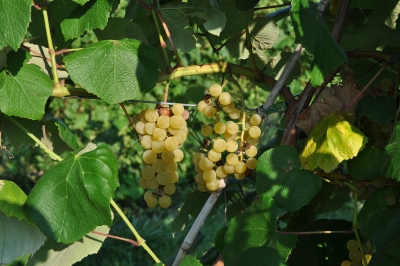
Edelweiss grape
Despite my affection for foxy grapes, for many years my farmden lacked a good ol’ Concord vine. I finally planted one about 6 years ago, ate the fruit for a couple of years, then decided the flavor didn’t warrant my growing it. Yesterday I tasted a friend’s Concord grapes and they were delicious. What’s up? Did my nursery source for my Concord vine mix up labels? Could the difference be due to terroir, a concept that takes into account almost everything: soil, climate, slope, sunlight, the geology and geography of a particular region, and as much more as needed to lend it a certain mystical quality? (I delve into terroir in depth in my book The Ever Curious Gardener.) I took a cutting to make a plant and in a few years will check out the flavor of that “Concord” here.
For the past few weeks, I have Elmer Swenson, a dairy farmer and grape breeder who lived near the Wisconsin-Minnesota border, to thank for the grapes I am eating. Some of my favorite varieties reflect his skill as a breeder. Swenson Red berries are medium sized, sweet, fairly foxy, and just slightly slipskin. I do wish that Edelweiss was not so vigorous, but the berries are deliciously sweet and foxy. Also delicious and foxy is Brianna. And for a variety leaning towards the vinifera end of the gustatory spectrum, there’s Somerset Seedless. Thanks Elmer.
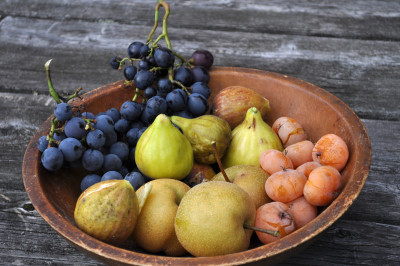
Fruit bowl with fig, grape, persimmon, nashi


Thank you for that, Lee, most enjoyable! I, too, prefer the foxy grapes, and several years ago I purchased 4 vines from St Lawrence. I believe I have 1 Swenson red, and if my memory serves me correctly, I have King of the North (if that’s not it, I am confusing it with a sweet pepper name!). They have yielded good fruits for myself and the birds (wild and domestic!) but this year lots of leaf but barely any fruit at all. Not sure what is up with that. The Japanese beetles were fierce, but my chooks do a good job eating them.
“Chooks”? That problem could be due to incorrect pruning.
a bowl of autumn! I had to look up nashi but find the others so appealing. The persimmons seem to softly glow from within.
Yes!
Lee, the last picture shows persimmons, is that this year?
It’s not this year, but it could have been. All those fruits are ripe now (not Concord grapes, which I no longer have, but plenty of other grapes are ripe).
Such an interesting history! I’m enjoying my St. Theresa seedless grape. Good vigor and super sweet when fully ripe. I’m training them up against the southern brick wall of my home. They’re above my central air system so they still get lots of air circulation in the summer!
Where are you growing St. Theresa? In what climate zone, or place?
I have it growing here in Western PA near Pittsburgh, Zone 6b. Got it from Raintree Nursery. Just propagated my 1st successful green cutting from it too!
Not sure what “it” is. Foxy grapes, in general?
“It” = St. Theresa Seedless Grape. That’s the grape I’ve been referring to.
Vitis labrusca x vinifera ‘St. Theresa Seedless’. A very hardy, mostly seedless, purple grape for Northern growers, from Elmer Swenson’s Wisconsin breeding program. This purple slipskin grape is loaded with large clusters of sweet, flavorful fruit that ripens in early September. The vigorous vine tolerates alkaline soils. Grows in USDA Zone 4-8.
I’m quite pleased with this grape. Not that I’ve grown so many kinds. But it becomes quite sweet once fully ripe. Dark skins like concord.
Uh oh, looks like I’ll have to try another Swenson grape variety.
Lee – appreciate the info! Unfortunately, you’ve inspired me and I now have another crop to plant!
Are you able to grow any grape cultivars with little to no chemical intervention? If so which are the best for that endeavor? (I’d prefer to go organic if possible.)
Yes, no chemical intervention. But I choose my varieties carefully for pest resistance and bag a number of bunches, besides giving them a sunny site and pruning religiously. Some varieties that have done very well here are Brianna and Concord.